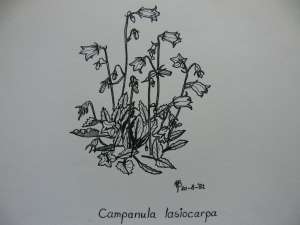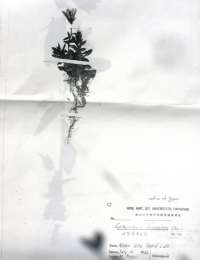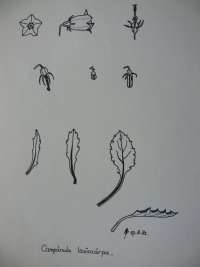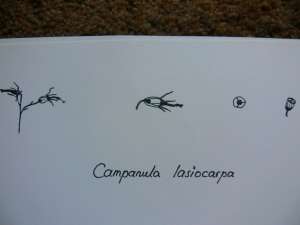Inhoud
lasiocarpa
Campanula lasiocarpa
Cham.
lasiocarpa:Orig 013276-0214-76 Locn 1A TR, geo: 50000 rec: PLNT: 1ab: 1, dis: ALASKA TO WASH.; N.JA, ayr: 76 1) lasiocarpa CHAM.:Orig 014724-0262-76 rec: SEED: Locn 1A AS: 1ab: 1, ayr: 76 2)Nomenclatuur
Synonym: Campanula algida Fisch.
Campanula lasiocarpa x Campanula nitida = ? polyploid or triploid progeny Campanula lasiocarpa x Campanula isophylla = ? alpine-type hanging plant
Names
J.: Iwagikyo- Iwagikkyo
Herbarium
Habitus
Nearly glabrous, tufted, dwarf perennial, 3-6 in.
Rhizomes elongate, branched, slender; stems 5-12cm long, loosely pong-pilose in upper part.3)Petite graceful plant with large dark-blue flower. Perennial small (6-12 cm) ryhlodernistoe plant with a thin creeping rhizome, straight stems and obratnolan-tsetnymi almost spinous-toothed leaves. Flowers solitary, terminal, funnel-shaped, 3-4 cm long, with more than the previous species, blades, cup without appendages. Flowers in June-July, fruiting in August. 4)
Leaves
Leaves spatulate, obovate, or linear, to 1 ¾ in. long, serrate.
Radical leaves few, rosulate, obloanceolate or narrowly obovate, 1.5-3cm long, 4-7mm wide, rounded to subacute, petiolate, with a few scattered mucronate teeth, loosely long-pilose on margin of petiole; cauline leaves few, sessile, small.5)
Perennial small (6-12 cm) ryhlodernistoe plant with a thin creeping rhizome, straight stems and obratnolan-tsetnymi almost spinous-toothed leaves. 6)
Flowers
Flower measuring, between 25 - 40mm (1 - 1 1/2 inch.)7)
Flowers erect, terminal on scapose stems, calyx without appendages, often woolly between the toothed lobes, corolla dark violet-blue, to 1 in. long, broadly campanulate. Flowers solitary; calyx prominently spreading-pilose, the segments ascending, broadly linear, 8-10mm long, few-toothed; corolla blue, 2-2.5cm long, glabrous. Aug.8)Petite graceful plant with large dark-blue flower. Flowers solitary, terminal, funnel-shaped, 3-4 cm long, with more than the previous species, blades, cup without appendages. Occasionally found belotsvetkovaya form (Takeda, 1938). Flowers in June-July, fruiting in August. 9)
Chromosomes
Number of diploid chromosomes (2n=34).
Fruit
Seed available, in small quantity. Species actually grown or used for breeding 10) Capsules erect.
20.00/p.10, 150.00/p.100 Campanulaceae11)
Varieties
- Campanula lasiocarpa var. alba
Species actually grown or used for breeding 12) 25.00/p.10, Campanulaceae13) White Campanula lasiocarpa are variable among seedlings and darken green leaves with larger flowers are more desirable. 14)
- Campanula lasiocarpa var. asiatica
- Campanula lasiocarpa var. hakusan (Hakusan-iwagikkyo = Jap.)
Native in Hakusan Mt. (2702) in central Japan, flowering in April to May, medium size flower blue color15).
- Campanula lasiocarpa var. hybride, open pollination16)
- Campanula lasiocarpa var. lasiocarpa
Campanula lasiocarpa ssp. lasiocarpa:Orig 014618-0284-77 Locn 1A NA, geo: 51001, rec: PLNT: 1ab: 1, dis: THE WHISTLER, JASPER, ayr: 77 17)
Campanula lasiocarpa ssp. lasiocarpa:Orig 016256-0284-78 Locn 8, geo: 51004, rec: SEED: 1ab: 1, dis: GUNANOOT RD., B.C., ayr: 78 18)
- Campanula lasiocarpa var. shirobana (Shirobana-iwagikkyo = Jap.). Flowering white color, medium size flower19).
- Campanula lasiocarpa var. shretoko (Shretoko-iwagikkyo = Jap.)
Flowering in July, short stem, large flower, light lavender color, one year take flowering from seed sawing20).
Breeding
OBSERVATIONS
The first thing you must realize is that you cannot practically expect to cross any species with any other, for the following reasons: * 1. Different numbers of chromosomes. This barrier alone cuts the number of possible crosses in half. * 2. Different flowering times. When the flowering period of Campanula bellidifolia is over, Campanula lasiocarpa begins, and later Campanula piperi. Unless you adequately save and store the pollen, or force a plant to bloom at a different time than it would normally, you cannot make some crosses. (To store pollen, put it in glassine envelopes, then in a jar containing about 1/4 inch of silica gel. Cover tightly and refrigerate.).21) The two Japanes alpine Campanula (Campanula lasiocarpa and Campanula pilosa var. dasyantha), are lovely, easy in culture and have been popular for very many years. Recently due to repetation of seedling their cultivation has been more easy.22)Living
It grows on rocks, sandy, rocky and herbaceous slopes coasts, on the volcanic cinder fields (Kuril Islands) and on stony ground and alpine meadows (Sakhalin). Mezopsihrofit.23)
Benefits
In SahKNII since 1965, growing out in the open on the ridges of the first portion. Well it grew. It grows in late March or April depending on the snow melts. It blooms at the end of June-early July, about a month, the seeds - in August. During flowering flowers cover sheet, forming a blue carpet. Plant height increases slightly to 9-13 cm, the size of the flower remain the same. Zimnezelenoe plant. When sowing a winter shoots appear in the first half of June. It is easy to culture. Required drainage, sunny location, but after June shading (Takeda, 1938). It has become the horticultural crops (Flora of the USSR, 1957). Specify in the Dictionary of Horticulture (Dictionary of Gardening, 1956) for rock gardens. Good unpretentious plant for stony hills. 24)
Origin
West, North-America and Japan.
Gravelly and sandy alpine slopes; Hokkaido, Honshu (centr. and n. distr.). - Sakhalin, Kuriles, Kamschatka, Aleutians, and Alaska.The area of the North Pacific such as: Russia (Sakhalin, the Kuril Islands rarely, usually all the islands, hunting, Kamchatka, Commander Islands, the Arctic), Japan (Hokkaido, Honshu), the Aleutian Islands, North America. Arktoalpiysky views. Occasionally found belotsvetkovaya form (Takeda, 1938). 25)
This species grows Japanese mountains through Aleutian Islands and Alaska, but Japanese ones are more dwarf and showy. Als in the districy Shiretoko, Hokkaido, Mt. Hakusan.26),27) We have some native species of Campanula plants (You can see on Copy-1.{28)} and with-in these species Campanula lasiocarpa and Campanula pilosa var. dasyantha are very important in Japan as wild and alpine plants under amature group. Japanese alpine plants grower said: “Both species are most beautiful in Campanula genus and very good for the small pot plants and rock garden”. Iwagikkyo (Campanula lasiocarpa)is a native in high mountain area and northern part of Japan and cultivation is very difficult. Natural distribute of Iwagikkyo is the mountains in central to north Hokkaido and Chishima islands. They has very variant in the growth habit but usurly very dwarf growth. 29)



